It has been the most unique year in the history of Canada’s Express Entry immigration system.
Starting with all-program draws on hold for the first six months, they then returned for five months, before being suspended again due to a computer problem.
A massive backlog of applications at Immigration, Refugees and Citizenship Canada (IRCC) only showed signs of falling in the latter part of 2022.
It all meant that, after seven years of growth since the system was introduced in 2015, this was the first year in which the brakes were fully applied.
But that is only temporary. With record immigration levels planned for the next three years, rising to 500,000 per year by 2025, expect Express Entry to roar back to life in 2023 as Canada tackles a chronic labour shortage.
What is Express Entry?
Express Entry is an immigration system implemented by Canadian immigration authorities (IRCC) on January 1, 2015 which manages skilled worker applications under Federal Economic programs. This includes the Federal Skilled Worker Program, the Federal Skilled Trades Program the Canada Experience Class and parts of the Provincial Nomination Programs.
The graph showing annual Invitation to Apply numbers has been on a steady increase since 2015, the only blip coming in 2019 when slightly fewer invites were issued than in the two previous years.
With 2021 seeing a record number of 114,431 ITAs, the expectation was this would continue in 2022. But the backlog meant it was not to be.
In fact, the number of ITAs plummeted 60 percent to just 46,538, as IRCC paid the price for mismanagement of the system during Covid-19.
It turned out Ottawa simply did not have the processing capacity to deal with the thousands of applications it received in 2020 and 2021, including through Express Entry and the one-off Temporary to Permanent Residence Pathway.
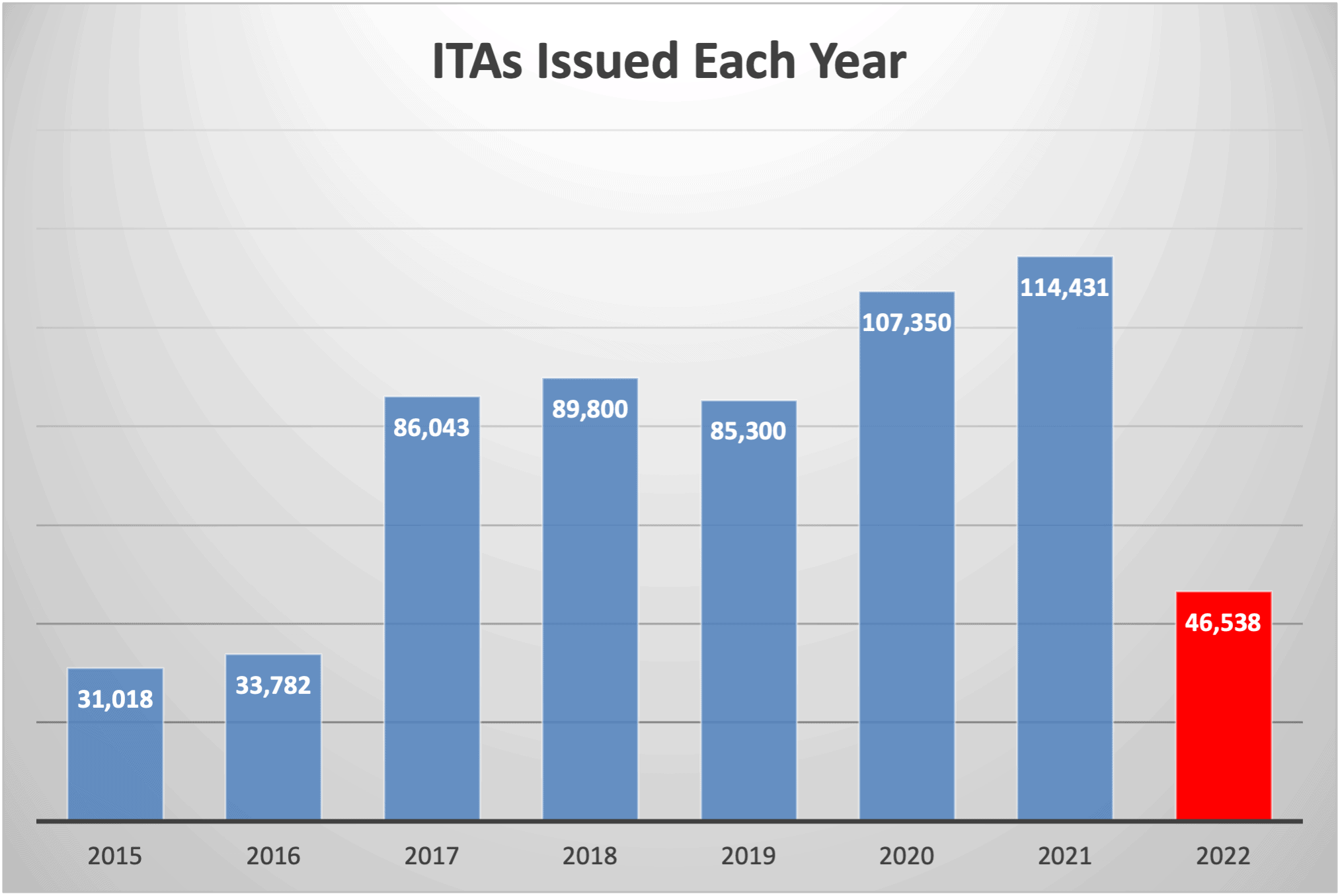
All program draws were suspended by the end of 2021, and would not return until July 2022, even then with the backlog still way of 2.5 million applications, including for temporary and permanent residence and citizenship.
Heading into 2023, the backlog remains over 2 million, although it is under 50,000 for Express Entry-linked programs.
Canada’s federal government has poured money into tackling the backlog, so expect it to fall further and more sharply next year.
Another major development during 2022 was the introduction of a revamped National Occupational Classification System.
This led to overhauls from all the Provincial Nominee Programs, as they adjusted to a new TEER system that gave occupations a five-number code instead of four.
The rough equivalents are as follows:
| NOC 2016 | NOC 2021 |
| Skill Type 0 | TEER 0 |
| Skill Level A | TEER 1 |
| Skill Level B | TEER 2 |
| TEER 3 | |
| Skill Level C | TEER 4 |
| Skill Level D | TEER5 |
It essentially means officials and employers are better able to pinpoint the workers they want in preparation for the introduction of occupation-specific draws in early 2023.
The new system also meant 16 new jobs became eligible for Express Entry, including truck drivers and nurses.
Watch
Here is a full list of the newly-added occupations, which all fell under the Federal Skilled Worker Program when NOC 2021 was launched in November:
- (NOC 13102) Payroll administrators
- (NOC 33100) Dental assistants and dental laboratory assistants
- (NOC 33102) Nurse aides, orderlies and patient service associates
- (NOC 33103) Pharmacy technical assistants and pharmacy assistants
- (NOC 43100) Elementary and secondary school teacher assistants
- (NOC 43200) Sheriffs and bailiffs
- (NOC 43201) Correctional service officers
- (NOC 43202) By-law enforcement and other regulatory officers
- (NOC 63211) Estheticians, electrologists and related occupations
- (NOC 73200) Residential and commercial installers and servicers
- (NOC 73202) Pest controllers and fumigators
- (NOC 73209) Other repairers and servicers
- (NOC 73300) Transport truck drivers
- (NOC 73301) Bus drivers, subway operators and other transit operators
- (NOC 73400) Heavy equipment operators
- (NOC 93200) Aircraft assemblers and aircraft assembly inspectors
Read More
Canada Express Entry 6-Month Review: Slow First Half of 2022, With All Eyes On Return Of All-Program Draws
How Do I Get In The Canada Express Entry Pool?
What Is A Canada Express Entry Profile?
New Applications Through Express Entry To Be Processed In 6 Months From July
New Canada Express Entry Changes To Allow Occupation-Based Invitations
Given the low number of ITAs issued in 2022, it is no surprise to see that none of the quarters were anywhere near the top 10 for invitations.
After 2021 saw the top two quarters in the history of the system, 2022 saw some of the lowest-ever ITAs numbers, with the fourth quarter seeing the most invitations AT 18,500.
It should be noted that were it not for a computer issue connected with the implementation of NOC 2021, the fourth quarter was well on its way to entering the top 10, with four draws of 4,250 ITAs or more.
The quarter was on target to reach 28,000 ITAs until the November stoppage, which would have been the fifth highest of all time.
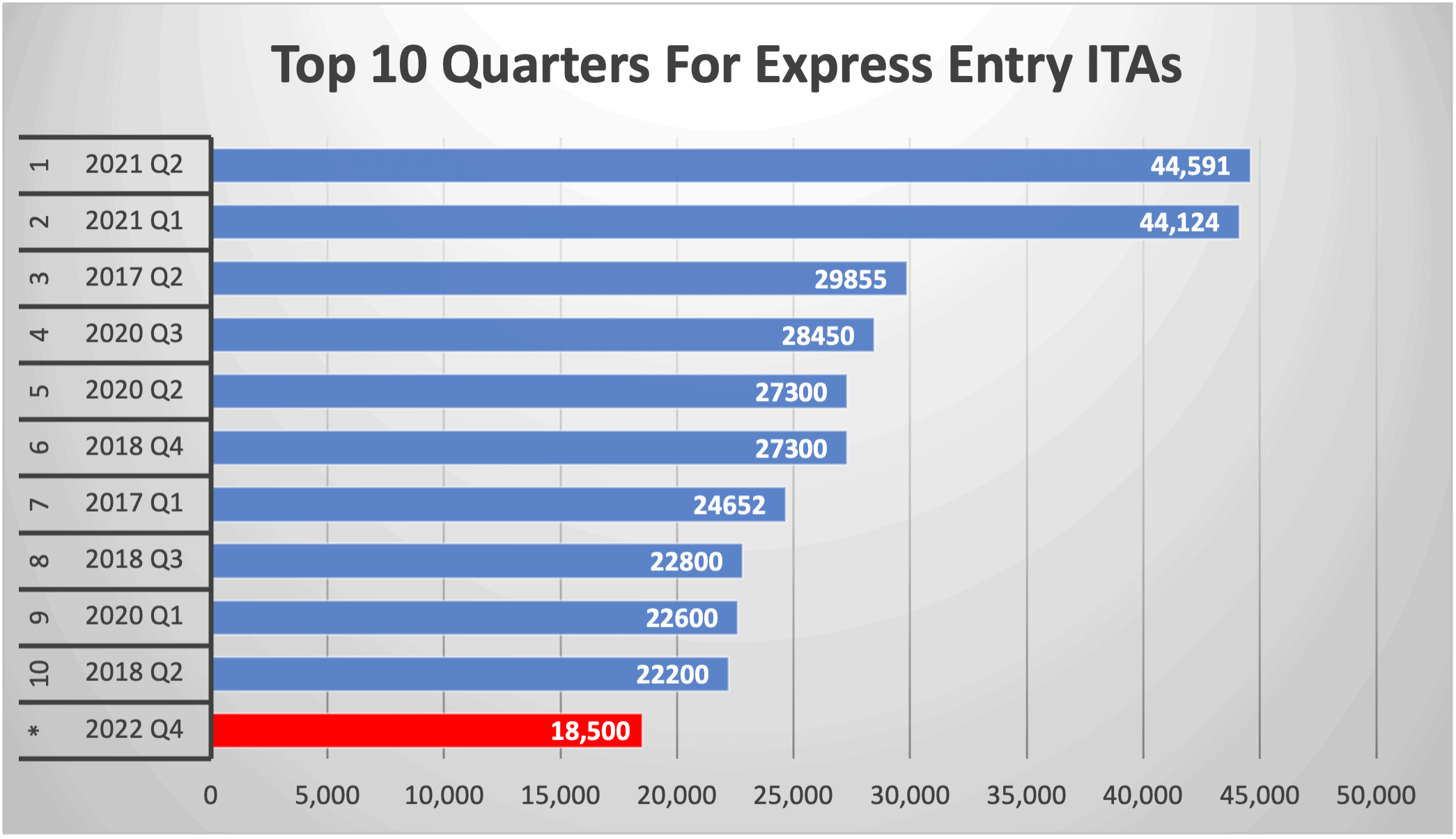
As it was, draws came to a shuddering halt on November 23, linked to what IRCC called an unknown computer glitch that still had not been resolved at the time of writing.
Up to that point, it had very much been a year of two halves for the Express Entry system, with January to June featuring low draw numbers through PNPs only, before the steady increase was seen since July as IRCC carefully resumed all program draws.
In the graph below, PNP draws are coloured orange and all program blue, showing exactly the change seen from July 6 onwards.
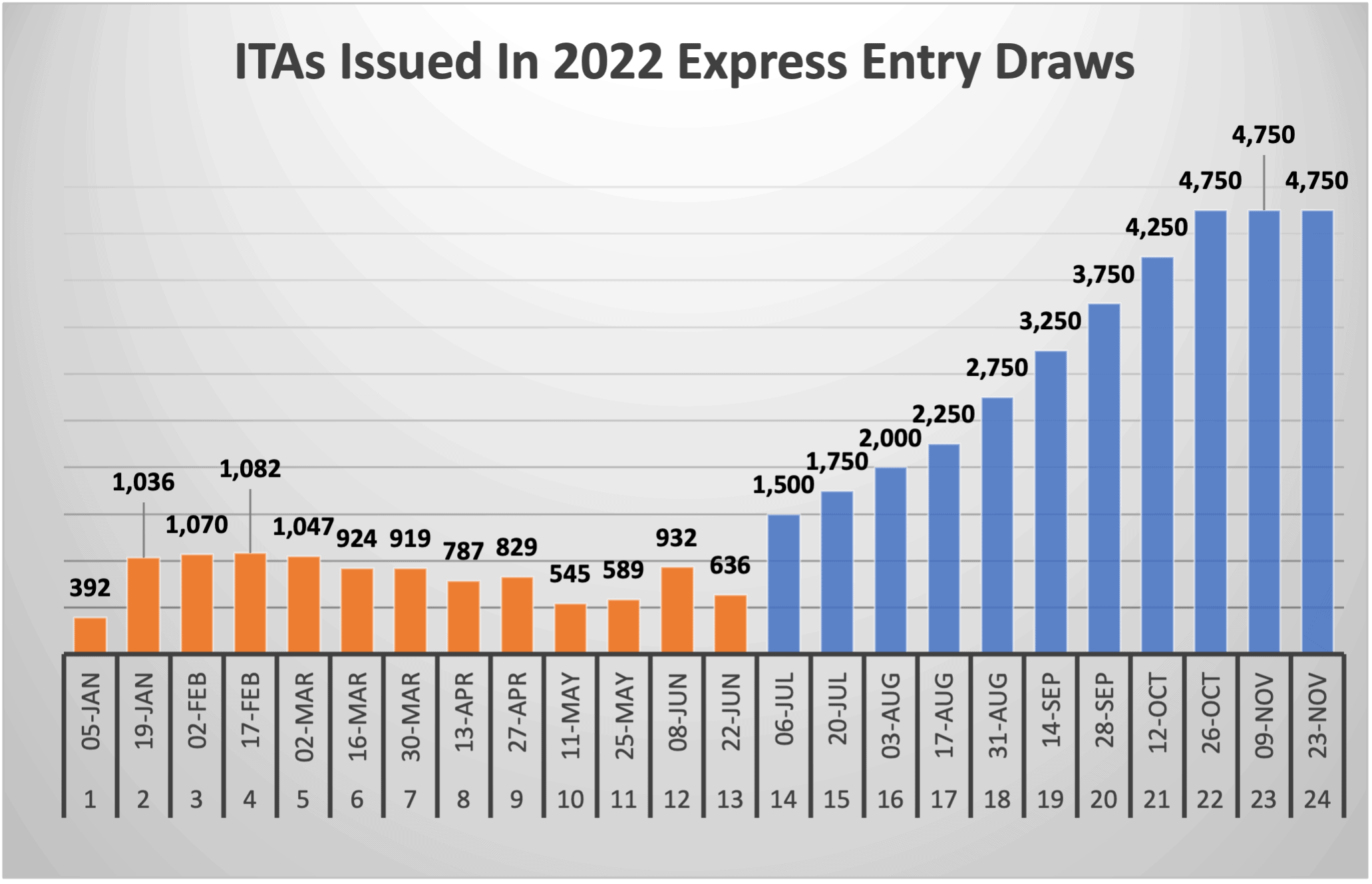
With the knowledge that Canada’s immigration levels plan would see sharp increases in the next three years in the Federal High Skilled category, IRCC officials were able to confidently increase draw sizes from 1,500 ITAs in July to 4,750 in November.
Were it not for the computer issue, they may well have grown still further in December.
The rising number of ITAs had the effect of driving down the minimum Comprehensive Ranking System score.
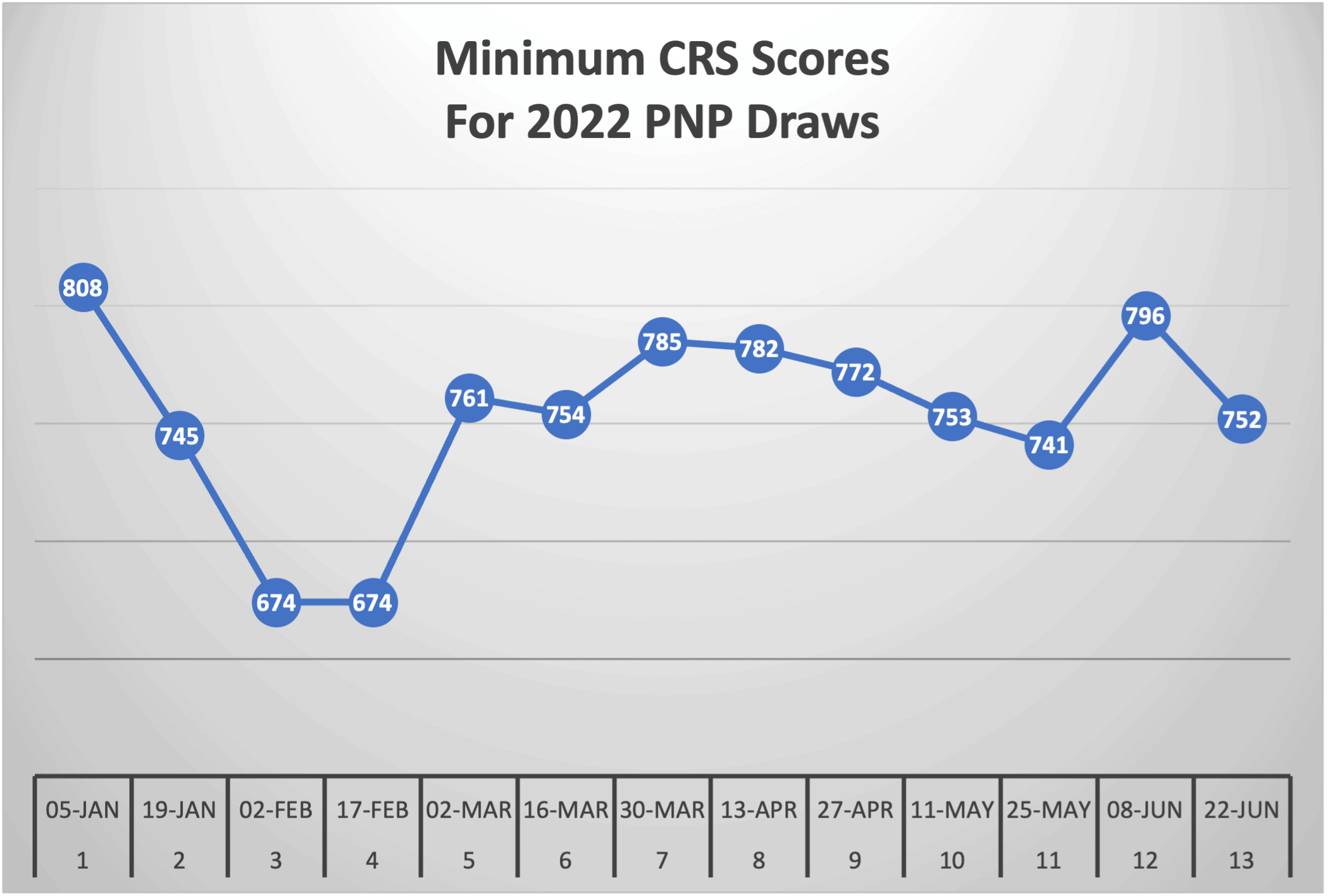
Candidates were disappointed to see the CRS debut at 557 for the return of all program draws, many having been sat in the Express Entry pool for months or years, waiting to see a return of scores in the lower 400s seen before Covid-19.
But IRCC had to essentially relaunch the entire system in July, with months of profiles being pumped into the pool and none moving out the other end. It was no surprise, therefore, that the standard of profiles had increased in that time.
A positive for those with scores in the 400s was that CRS scores dropped with every draw from July onwards, from 557 down to 491. That figure would surely have dropped even further, had draws been allowed to continue in December.
Candidates should be aware that the current suspension of draws is likely to mean a slightly higher minimum CRS score for the next all-program draw, whenever possible.
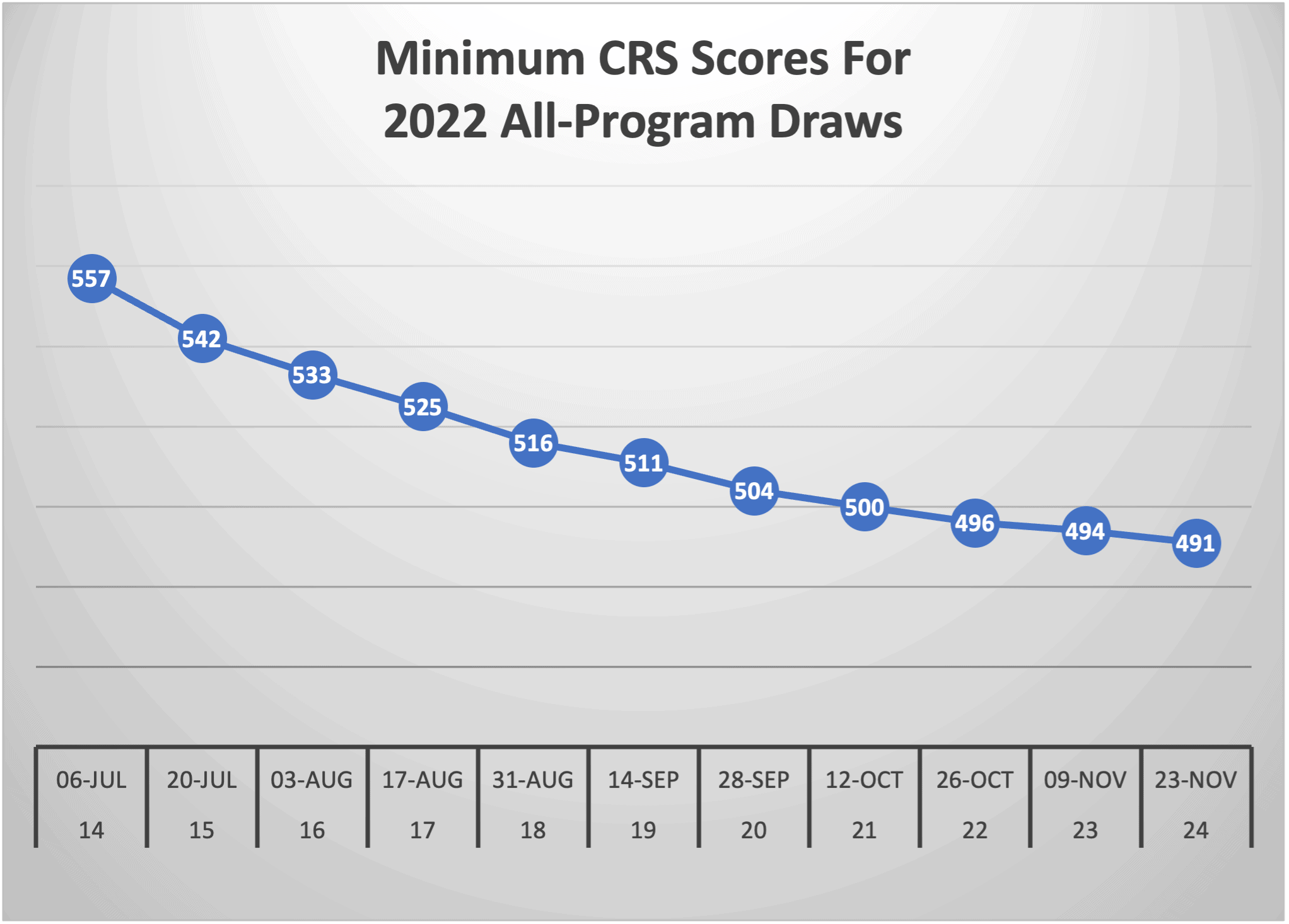
While there was a clear pattern in the CRS scores for all program draws in the later part of the year, the same could not be said for the PNP draws in the first six months.
With 600 points for a provincial nomination and relatively low ITA numbers, it is logical that the minimum score will move around almost at random, as was seen between January and July.
Express Entry in 2023
Looking forwards, 2023 promises to be a bumper year for Express Entry and Canada immigration as a whole.
IRCC will be working feverishly to solve the issue that causes the suspension of draws. It has an immigration target of 465,000 in 2023, including 82,880 in the Federal High Skilled category.
That number rises sharply to 109,020 in 2024 and 114,000 in 2025, as the final 25,000 newcomers through the TR to PR Pathway are slated to arrive in 2023. The quota for the TR to PR Pathway was taken from the Federal High Skilled category when immigrants could not be welcome from abroad during the pandemic.
Canada’s 2023 to 2025 Immigration Levels Plan
| 2023 | 2024 | 2025 | ||
| Overall Planned Permanent Resident Admissions | 465,000 | 485,000 | 500,000 | |
| Economic | Federal High Skilled | 82,880 | 109,020 | 114,000 |
| Federal Economic Public Policies | 25,000 | – | – | |
| Federal Business | 3,500 | 5,000 | 6,000 | |
| Economic Pilots: Caregivers; Agri-Food Pilot; Rural and Northern Immigration Pilot; Economic Mobility Pathways Project | 8,500 | 12,125 | 14,750 | |
| Atlantic Immigration Program | 8,500 | 11,500 | 14,500 | |
| Provincial Nominee Program | 105,500 | 110,000 | 117,500 | |
| Quebec Skilled Workers and Business | 33,900 | To be determined | To be determined | |
| Total Economic | 266,210 | 281,135 | 301,250 | |
| Family | Spouses, Partners and Children | 78,000 | 80,000 | 82,000 |
| Parents and Grandparents | 28,500 | 34,000 | 36,000 | |
| Total Family | 106,500 | 114,000 | 118,000 | |
| Refugees and Protected Persons | Protected Persons in Canada and Dependents Abroad | 25,000 | 27,000 | 29,000 |
| Resettled Refugees – Government-Assisted | 23,550 | 21,115 | 15,250 | |
| Resettled Refugees – Privately Sponsored | 27,505 | 27,750 | 28,250 | |
| Resettled Refugees – Blended Visa Office-Referred | 250 | 250 | 250 | |
| Total Refugees and Protected Persons | 76,305 | 76,115 | 72,750 | |
| Humanitarian and Other | Total Humanitarian & Compassionate and Other | 15,985 | 13,750 | 8,000 |
IRCC has made abundantly clear its plan to introduce occupation-specific invitations in 2023, a tactic employed by many of the provinces for several years.
This will make Canada’s immigration system even more nimble than it is already (it is the envy of the western world).
If an industry such as trucking or an occupation such as nurses has a shortage, IRCC now has the power to address it by targeting that profession with a draw, or a series of draws.
It also sends a clear message to potential application in the targeted field that Canada wants them, which should in theory lead to more invitations.
Canada is entering 2023 in an extremely strong position on immigration, with increased processing capacity, huge annual targets and one of the world’s most sophisticated systems to back that up. It is set to be an exciting year.